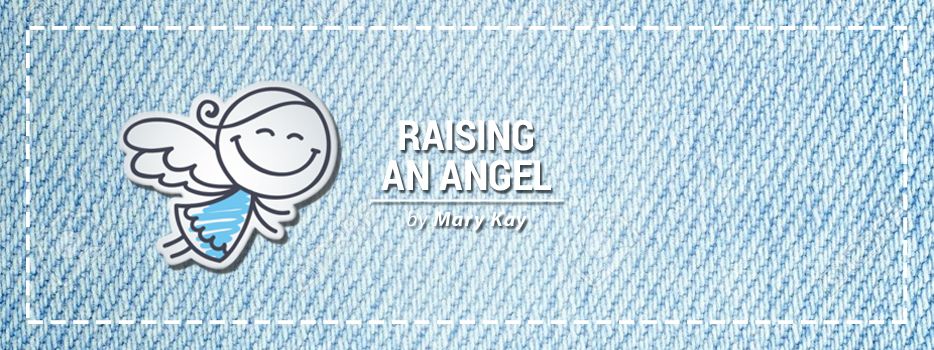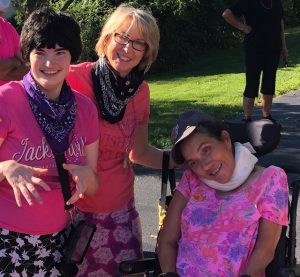I’m Thankful for Angel Advocates

When my daughter, Jessie, was 2, she saw a balloon while we were waiting in line at the market. I pulled it closer for her to see, then let it go. She smiled as it floated to the end of its string.
After observing this, the shopper next to me blurted out, “There’s something wrong with her!”
I was horrified that he’d utter such a thing. I guess he expected her to have a meltdown because she didn’t get to keep the balloon. As hurtful as that comment was, little did I know he was right.
When Jessie was 2 1/2, her doctor recommended enrolling her in an early intervention program because she was a late walker with an ataxic gait and had only spoken one short phrase. When she turned 3, we had her first individualized education program (IEP) meeting.
All I remember from the IEP meeting is being told that I had to be Jessie’s advocate because she was developmentally delayed. But what did that really mean?
At the time, I didn’t realize it meant I would need to fight for what she needed.
You can break down advocates into two general groups: those who are called to support a loved one who may not have a strong voice (such as a child, a parent, or even a pet), and those who volunteer because they see others in need. The latter often aren’t related, but feel moved to do something.
I’m a combination of both. However, our friend Sara exemplifies what it means to be the volunteer type of advocate.
Sara met Jessie when Sara was in high school and was aware of some of the challenges we faced. However, it wasn’t until Jess was in her final semester that Sara said she noticed changes in her.
I explained that with the help of Jessie’s school caseworker, we had moved her out of the classroom and into a workshop. Jessie needed a boot camp, and the man who ran the program was just the type of person she needed: in charge. Not only did he assemble a team to work with Jessie, but he worked with her personally, too. This groundwork prepared Jessie for what was to come next.
It was then we found Speak for Yourself (SfY), an augmentative and alternative communication (AAC) app, which gave Jessie a new voice. By turning the iPad into a communication device, the app finally enabled Jessie to express herself and allowed her personality and intelligence to emerge.
Because SfY only has two layers to navigate to find words, rather than multiple layers where it is easier to get lost, Jessie could find the word she was looking for more quickly and easily. (As her vocabulary grew, her previous device became more difficult to use.) SfY also includes more fringe words, which kept her engaged.
Sara was so excited and interested in Jessie’s story that she felt it should be shared, so she connected us to an editor at a local magazine, Moxie Woman. Awareness is not only an integral part of advocacy, but the first step. Most people haven’t seen someone use an AAC device. Even fewer have heard of Angelman syndrome. This article focused on both.
We all take talking for granted until someone cannot talk to you. However, because Jessie doesn’t speak, there’s a misconception that she is too severely challenged to understand what others say.
Jessie is not the only one to benefit from Sara’s passion for raising awareness. Sara has volunteered with the local Boys & Girls Club, led the charge to preserve a part of local history, and when she learned her neighbor raised money for children who had a parent with ALS, knocked on her door and volunteered to do an Ice Bucket Challenge.
Two years later, by a cruel twist of fate, ALS would attack Sara. This was devastating to all of us who know her. However, she has used this as an opportunity to raise awareness.
Over Labor Day weekend, Jessie participated in a walk with Sara for the nonprofit Hope Loves Company. For many years, Sara has been an advocate for Jessie. Now, Jessie is walking for Sara because it is our turn to be hers.
It’s easy to advocate for your child. But wouldn’t the world be a better place if more people stepped out of their comfort zone when they saw a need? I don’t want to be one of those people who only offer support to someone after a life-changing event. I want to be more like Sara.
To read more about our journey, visit my blog. We wouldn’t even have a story if Jessie hadn’t found her AAC voice. Also, check Angelman Syndrome News each month for future columns.
***
Note: Angelman Syndrome News is strictly a news and information website about the disease. It does not provide medical advice, diagnosis, or treatment. This content is not intended to be a substitute for professional medical advice, diagnosis, or treatment. Always seek the advice of your physician or other qualified health providers with any questions you may have regarding a medical condition. Never disregard professional medical advice or delay in seeking it because of something you have read on this website. The opinions expressed in this column are not those of Angelman Syndrome News, or its parent company, BioNews, and are intended to spark discussion about issues pertaining to Angelman syndrome.









Comments
Kerry Brooks
I find it very hard that my daughter can not communicate I’ve tried in vain but it never works for us she just doesn’t get it. She is 14 now and it’s the vain of our lives. I would like to know more about this App if possible. Thankyou Kerry Brooks.
Mary Kay
WE did a lot of guessing when Jess was 14. She gave us a basic idea as to what she wanted. Being a parent, we can read them to a point, but we can't read their mind. I think once the lightbulb went off for Jess, and she realized the power of her words, being able to be specific for what she wanted, that was motivating.
With SFY, you build language one word at a time and begin with the things that interest and motivate them. For example, Jess loves ice cream. If she asked for it, she got it (in the beginning, now it is just part of a conversation). This encouraged her to expand for other things that she wanted to say. SFY allowed her to say fringe words and things that she thought were funny.
In the beginning, Jess wasn't able to isolate her finger. Also, her hand-eye coordination was not calibrated. It took me over 20 years to figure that out.
The best thing you can do is talk about everything. What you are doing and why. It may seem like a one-way conversation but they are listening. It's so easy for them to give up trying to communicate because it doesn't come easy.
Not sure if any of this helped. Let me know if you want me to expand.
Mary Kay
Speak for Yourself has a robust vocabulary, over 14,000 words available, as well as room to add customized words. All words are available in two taps (there are only two layers). This was huge for Jess because other AAC's had multiple layers and it was easy to get lost. It also took longer. Jess began with about 15 words (don't remember exactly) and now is using about 1,500 words. This doesn't include the words she uses in the Babble feature (which opens all the preprogrammed words,5,227) For more information, check out www.speakforyourself.org
Joe Pierce
Thanks for sharing this!